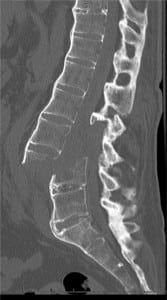| Author | Affiliation |
|---|---|
| Sundip N. Patel, MD | UMDNJ-RWJMS-Camden, Cooper University Hospital, Department of Emergency Medicine, Camden, NJ |
| Alan Turtz, MD | Cooper University Hospital, Department of Neurosurgery, Camden, NJ |
| Angela Dixon, MD | UMDNJ-RWJMS-Camden, Cooper University Hospital, Department of Emergency Medicine, Camden, NJ |
| Steven Yocom, DO | Cooper University Hospital, Department of Neurosurgery, Camden, NJ |
A previously healthy 46-year-old male presented to the emergency department with the sole complaint of lower back pain after being struck by a car while walking. Physical examination revealed the patient to be hemodynamicaly stable and in moderate distress secondary to back pain. Maintaining spinal precautions, the patient was log-rolled and found to have midline lumbar spine tenderness with a visible step off. The patient was neurologically intact with equal strength and sensation in his lower extremities. Computed tomography revealed a transverse comminuted fracture of the lumbar four (L4) vertebral body with severe anterior displacement of the spine (Figure). In addition, sydesmophytes were noted throughout the spine consistent with previously undiagnosed ankylosing spondylitis.

Ankylosing spondylitis increases the risk of clinical vertebral fractures secondary to osteoproliferation and syndesmophyte formation which makes the spine more rigid.1 While osteoporosis is also common in patients with ankylosing spondylitis, vertebral fractures appear to be more closely related to the duration and structural severity of the disease as compared to bone mineral density.2 Physicians must have a high index of suspicion for vertebral fractures in patients with ankylosing spondylitis as the stiff and brittle nature of the spine predisposes them to fracture, even with minimal trauma.3
While most injuries in patients with ankylosing spondylitis occur in the cervical spine, this case involves the lumbar spine. Although less common, thoracolumbar fractures are four times more common in patients with ankylosing spondylitis than in the general population.4 The incidence of associated neurologic deficit is relatively high, occurring in over half of patients with thoracolumbar fractures.3,5 Delays in diagnosis of vertebral fractures in patients with ankylosing spondylitis can lead to the development of secondary neurological deficits during movement for tests and procedures. These patients require tailored spinal precautions in order to maintain their kyphotic curvature and prevent relative hyperextension.
Footnotes
Supervising Section Editor: Sean Henderson, MD
Submission history: Submitted: August 19, 2010; Accepted August 23, 2010.
Reprints available through open access at http://escholarship.org/uc/uciem_westjem
Address for Correspondence: Sundip N. Patel, MD, Department of Emergency Medicine, Cooper University Hospital, One Cooper Plaza, Camden, NJ 08103
Email patel-sundip@cooperhealth.edu
Conflicts of Interest: By the WestJEM article submission agreement, all authors are required to disclose all affiliations, funding sources, and financial or management relationships that could be perceived as potential sources of bias. The authors disclosed none.
REFERENCES
1. Vosse D, Landewe R, Van der Heijde D, et al. Ankylosing spondylitis and the risk of fracture: results from a large primary care-based nested case-control study. Ann Rheum Dis. 2009;68:1839–42.[PubMed]
2. Ghozlani I, Ghazi M, Nouijai A, et al. Prevalence and risk factors of osteoporosis and vertebral fractures in patients with ankylosing spondylitis. Bone. 2009;44:772–76. [PubMed]
3. Olerud C, Frost A, Bring J. Spinal fractures in patients with ankylosing spondylitis. Eur Spine J.1996;5:51–55. [PubMed]
4. Cooper C, Carbone L, Michet CJ, et al. Fracture risk in patients with ankylosing spondylitis: a population based study. J Rheumatol. 1994;21:1877–82. [PubMed]
5. Hitchon PW, From AM, Brenton MD, et al. Fractures of the thoracolumbar spine complicating ankylosing spondylitis. J Neurosurg. 2002;97:218–22. [PubMed]


